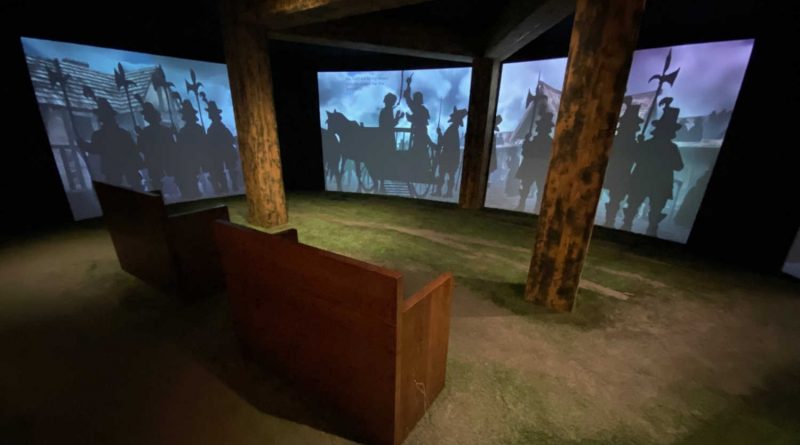Executions: Museum of London Docklands exhibition explores 700 years of public executions in London
The Museum of London Docklands’ special exhibition, Executions, tells the story of the publicly executed, the Londoners who witnessed their deaths, and the impact of executions on the capital’s landscape, economy, and society.
As I exit West India Quay DLR station, I am met with the sounds of construction work, mingling with the squawks of the gulls that fly above.
To my left are the gleaming glass buildings of Canary Wharf. To my right is a brown-bricked building that was once a dockside warehouse, but now houses the Museum of London Docklands and its newest special exhibition “Executions”.
“Executions” explores how public executions were an undeniable feature of city life for over 700 years. Even today, hints of this uncomfortable past can still be seen across the capital.
The exhibition showcases a range of objects, paintings, and projections that tell the rarely told and tragic human stories behind these executions. Many of the items on display have rarely been seen before.
Stepping into the past
One of the things that differentiates “Executions” from other exhibitions is how immersive it is.
As you walk into the exhibition, there is a distinct wooden smell evocative of the gallows. Looking around you will see that there are no gallows, but wooden scaffolding does form part of the exhibition setting.
You may need a moment for your eyes to adjust to the dim lighting. The exhibition is set out like a winding path in the dark, you don’t know what awaits you.
Further along, you will see a long metal contraption called a gibbet cage. These cages were used to display the executed bodies, for crimes such as murder and piracy.
Stepping closer to inspect the cage, a sound recording plays the cries of birds and the buzzing of flies that would have surrounded the rotting body, which could be left there for years as a warning to any would-be trouble marker.
A cocktail of emotions
As you walk around the exhibition, you can’t help but feel fear and pity when you come across gruesome execution stories. But you may be surprised to find that alongside these tragic tales are stories of faith, bravery and unbreakable will that fill you with awe.
One such inspiring woman was Anne Askew who at 24 became a devout Protestant. For this, she was tortured and burned at the stake but she refused to renounce her faith. Londoners such as Ann could be killed by the state, but could never be controlled.
Some visitors might find it shocking to learn that public executions were a form of public entertainment. The most infamous criminals could expect 50,000 to witness their fate from the educated middle classes to ‘whores and rogues’. It cannot be denied that the public was darkly obsessed with criminality.
As you examine the exhibits, you will be chilled when you find mentioned the part of London you call home. This will make clear to you that no part of this city had been left untouched by the tens of thousands of public executions that took place from 1196 to 1868.
In fact, London’s courts condemned more people to death than those in the rest of the country combined.
The ballad of Jack Hall
This room captures the essence of the exhibition. Projections across three walls show the animated stories of executions.
When you hear the speeches from the condemned, it brings home how this now alien practice touched and brutally ended the lives of thousands, from those who lived on the margins of society to a King.
As you leave the projection room you will be followed out by the sweetly sung lyrics “My neck shall pay for all when I die”, from the execution ballad Jack Hall.
Light after the darkness
As you enter the final part of the exhibition, you will learn that by the 1860’s public executions were increasingly at odds with ambitions to modernise and civilise London and in 1868, public executions were finally abolished.
However, the final exhibit makes clear that there is further progress yet to be made. Fifty-five countries retain the death penalty and 579 executions in 18 countries, were recorded by Amnesty International in 2021. A sombre thought on which to leave the exhibition.
Before you exit the museum, you can head to the gift shop and pick up a souvenir. If you can appreciate a little gallows humour and you have a sweet tooth you may enjoy a “well-executed dark chocolate candied ginger”.
Stepping back outside, you leave behind the London of 700 years ago. Everything will look the same, but it will feel a little different as you now carry with you the stories of Londoners’ of long ago that deserve to be remembered.
This experience can also be shared with younger visitors aged 12+. To buy tickets and for more information visit Museumoflondon.org.uk/museum-london-docklands/whats-on/exhibitions/executions. There is a free audio tour available and the exhibition will be running until 16 April 2023.


Articles published here provide wealth of invaluable information of East End life and history, needs to be preserved.